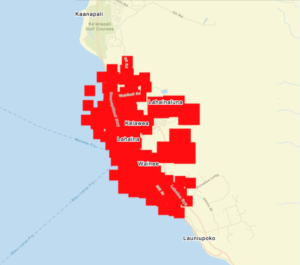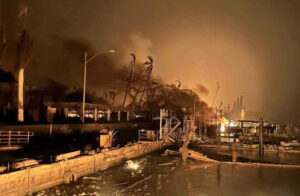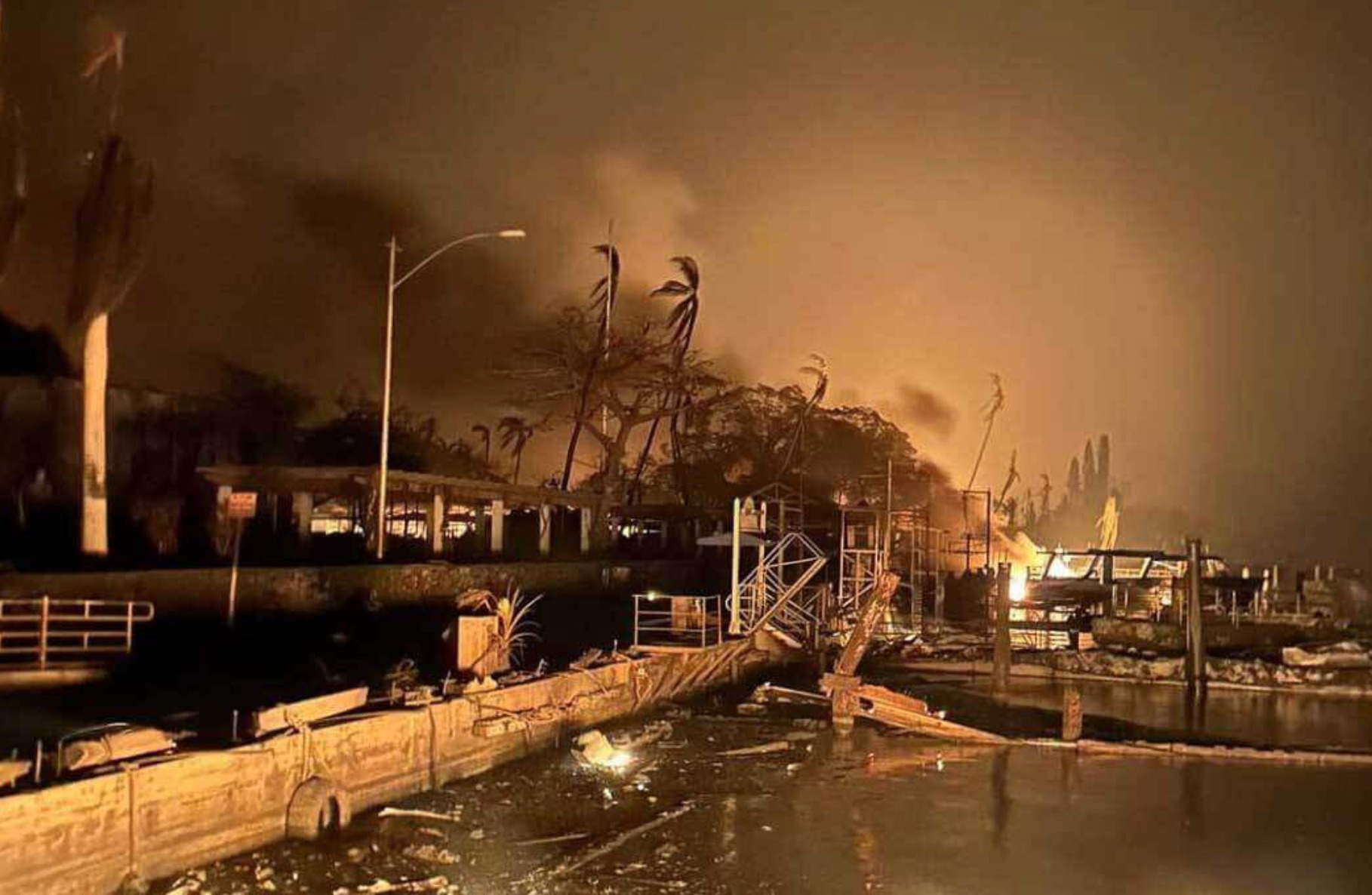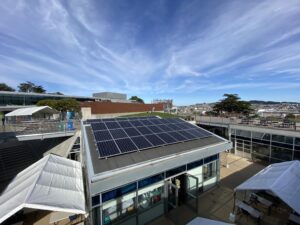On August 8, 2023, wildfires swept across the island of Maui, Hawaii, killing at least 97 people and marking the deadliest wildfire in U.S. history in over a century. In the aftermath of the devastation that has left Maui to begin the long process of reparation, casual tourists and frequent visitors of the island alike are left to wonder whether tourism in Hawaii is currently appropriate at all.
The devastation of the Maui fires primarily affected the historic town of Lahaina in Maui County and burned an estimated 2,170 acres, decimating homes, businesses and historical sites. In other areas of Maui such as Olinda and Kula, the fires have burned an estimated additional 1,200 acres. Hawaii’s electric utility, Hawaiian Electric, released a statement that said that the fire on August 8 “appears to have been caused by power lines that fell in high winds.” However, Hawaiian Electric seemingly blamed Maui County for the second fire that ignited later that afternoon and tore through downtown Lahaina.
In the weeks that followed the Maui fires, several areas of Maui and the Big Island of Hawaii began the process of searching for missing persons, repairing the damage and finding housing and health services for survivors. The day after the fires, the Hawaii Tourism Authority stated visitors on “non-essential travel” were being asked to leave Maui and strongly discouraged non-essential travel to Maui. The agency said that the Maui community needed time to heal and focus on the needs of the survivors.
After the initial fires, the number of visitors arriving on Maui declined by 70%, down to about 2,000 visitors per day according to the Associated Press. The message to cancel upcoming trips to Maui gained traction on social media platforms such as Instagram and TikTok. Lahaina resident Kate Ducheneau implored tourists to “Cancel your trip. Now” in a TikTok video posted on August 13, which has over two million views. On August 10, 2023, the nonprofit organization Āina Momona “dedicated to achieving environmental health & sustainability through social justice & de-occupying the Hawaiian lands” shared an Instagram post urging tourists to cancel their trips. “DO NOT TRAVEL TO MAUI,” the caption stated. “Do not convince yourself that your presence is needed on an island that is suffering this deeply.” As of October 2023, the post has gained nearly 90,000 likes.
However, the rapid decline in visitors to the island has been a big hit to Maui’s economy and small businesses that rely on tourism to pay the bills. On August 21, 2023, Hawaii governor Josh Green encouraged tourists to visit Hawaii, stating that while West Maui is still closed. “All of the other areas of Maui…and the rest of Hawaii are safe and open,” he said.
In recent years prior to the fires, the numbers of tourists visiting Hawaii have been steadily climbing. According to Ilihia Gionson, the Public Affairs Officer at the Hawaii Tourism Authority, Hawaii welcomed a record-setting number of visitors in 2019 with 10.4 million visitors across all islands. In the first seven months of 2023, there were a total of 5.9 million visitors with an expenditure of nearly $13 billion, which supports an estimate of 200,000 jobs on the Hawaiian Islands. “In a state of a million and a half people, that’s a significant chunk of folks,” Gionson said. “If all of the visitors [at a time] put together were a county, it’d be the second largest county in the state.”
Economists estimate that around 40% of Maui’s Gross Domestic Product (GDP) is associated with tourism. According to the Bureau of Economic Analysis, the GDP for Maui and surrounding islands was $8.34 billion as of 2021. In a survey conducted July 2023 by the Hawaii Tourism Authority, 67% of residents across the four islands expressed “favorable” views of tourism in the state, but the same percentage of people agreed with the assertion: “This island is being run for tourists at the expense of local people.”

Photo courtesy of National Aeronautics and Space Administration
“It was difficult for the people of Maui to see [tourists] sipping pina coladas at the beach [after the fires],” said Eric Tao, the President and co-founder of the Hawaii Chamber of Commerce Northern California (HCCNC). “So at first [Maui locals] are saying, let us heal, let us repair, let us recuperate. But only one side of the island [is affected by the fires]. The whole entire east side, people still needed their jobs. It’s a very difficult kind of paradox, the need for tourism and stomaching the fact that some tourists don’t respect your culture or your people or your place.”
Kofi Kim, a junior at Palo Alto High School, visits Hawaii almost every year and traveled to Oahu in early September. “There it feels very separate from Maui…people there didn’t really seem as affected [by the fires]. In terms of not going, I feel like it’s important to continue going because the tourism industry is really big. A lot of people’s livelihoods rely on people going [to Hawaii],” he said.
In the past, tourism in Hawaii has had extremely damaging effects on the natural resources of the land. Deforestation and construction for the purpose of tourist destinations have destroyed ecosystems and the habitats of thousands of wildlife species. Additionally, tourism has made it difficult for native Hawaiians to practice their own cultural traditions peacefully. As of late, there has been a push to reframe the tourism industry in Hawaii into a regenerative model. In order to protect Hawaii’s lands and culture, Gionson believes that regenerative tourism is crucial to the future of tourism in the islands.
“Conventional tourism as we’ve known it often ends up as a net negative for the destination. People come, utilize resources, and leave,” he said. “Sustainable tourism minimizes the negative impacts to make it net neutral. Regenerative tourism endeavors to be a net positive for the destination so that visitors will leave the place better [than when they arrived].” According to Gionson, regenerative tourism can occur in ways such as supporting small, locally owned businesses and volunteering with local organizations in Hawaii.
Kawika Tao ’27 travels to Hilo, Hawaii nearly every summer to visit his grandparents and has observed the negative effects of the tourism industry on Hawaii. “In Honolulu and places in Maui, a lot of hotels are taking away from the natural resources that Hawaii has and using them for their own capitalist gain,” he said. “And the big corporate companies that are using Hawaii as a place for income are taking away from the local businesses…I think tourism used to be a good thing. And then it was turned by corporations into a money scheme, and now they’re abusing it in a way.”
But according to Eric Tao, San Francisco yields some of the most respectful tourists to Hawaii’s islands. “Unsurprisingly, San Francisco tourists in Hawaii are the most respectful, the most recognizing, and the most interested in the cultural aspects of Hawaii. I think it’s because of what we have here. It’s not that different, there’s a very diverse population here. [San Francisco] encourages respecting people’s perspectives and interests and cultures,” he said.

Photo courtesy of Wikimedia Commons
California sends more visitors to Hawaii than any other state in the U.S. According to a preliminary visitor statistics report by the Hawaii State Department of Business, Economic Development and Tourism, 277,418 Bay Area residents traveled to Hawaii in the first four months of 2023. “There’s a really strong affinity between the Bay Area and Hawaii. A lot of people have great memories there. They’re got the most money, they travel…[the Bay Area is] almost like a sister city or sister state,” Eric Tao said.
Eric Tao founded the HCCNC in 1999 as a resource for events and activities between Hawaii and the Bay Area, in addition to creating a sense of affinity, support and connection for Hawaiian residents of Northern California. Since its founding, it has grown from three members to 2000+ and has given out over $100,000 in scholarships to Hawaiian students studying in the Bay Area. In response to the Maui fires, the HCCNC has directly raised over $40,000 for the relief efforts and indirectly given hundreds of thousands of dollars to Maui. On October 21, 2023, the HCCNC is co-sponsoring a free outdoor concert event, Aloha by the Bay, to raise awareness and funds for Maui.
The tragic effects of the Maui fires continue to persist. The fires have exacerbated Maui’s already-present housing crisis, resulted in the decimation of historical and cultural sites, and dramatically set back the tourism industry that Hawaii’s economy depends on. But the fires have also marked a unique turning point in Maui’s history when it comes to deciding how to rebuild the west side of the island.
Eric Tao believes that the Bay Area will lend a hand in making these decisions. “I think [the Hawaiian community in the Bay Area] will be asked to provide a mainland perspective on how we should rebuild [Maui],” he said. “Some people want to rebuild it as a bigger and better tourist place. Some people want to rebuild it as a place that’s not so reliant on tourism, a place for locals to thrive. Imagine if Fisherman’s Wharf burned down. Maybe some of the locals would say, hey, let’s not make it a Disneyland. Let’s make it something more relevant, more genuine.”
According to Gionson, the future of Maui is dependent on tourism, but tourists must be considerate when visiting. “Compassionate, respectful, responsible travel is what will help Maui recover. That’s the kind of travel that is welcomed in the Hawaiian Islands. That means if there’s a no parking sign, don’t park there. If there’s a no trespassing sign, don’t go there. Visit where there’s a clear invitation,” he said.
As of October 8, all travel restrictions to the Hawaiian Islands have ended and, with the exception of Lahaina, all of West Maui is open to visitors again.







1хбет промокод на бесплатную ставку 1хбет промокод на бесплатную ставку
1xbet est une plateforme de paris en ligne leader qui propose un large éventail d’options de divertissement. Code promo pari gratuit 1xbet Pour tirer le meilleur parti de votre expérience 1xbet, il est crucial d’utiliser un code promotionnel 1xbet. Avec le code promotionnel 1xbet, vous pouvez accéder à des offres incroyables telles que des tours gratuits, des paris gratuits et des bonus de bienvenue. Aujourd’hui, nous vous proposons le dernier code promotionnel 1xbet qui vous offrira des avantages exclusifs. Êtes-vous prêt à profiter de toutes les opportunités passionnantes qu’offre 1xbet ? N’attendez plus et utilisez notre code promo bonus de bienvenue 1xbet pour commencer à gagner. Inscrivez-vous aujourd’hui et profitez au maximum de vos paris avec le meilleur code promotionnel pour 1xbet!